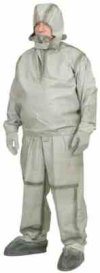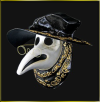The plague doctor mask and its history The Plague Doctor (Medico Della Peste) Around 1350 the culture in Europe changed, it became very bleak and morbid with. art representing this pessimism using images of death and suffering. This depression and pessimism was brought about by the prevalence of the black Plague. Nobody knew how to contain or prevent the onslaught of the Black Death and many of the supposed preventions/cures caused even more problems. For instance people believed that cats were in league with the devil, so cats being killed en masse. This meant that the rat population wasnt controlled by the cats hunting them and so the plague infested fleas were allowed to spread from host to host unhindered. It was during this backdrop that the Medico Della Peste (Plague Doctor) came about .Many believe The plague doctor was created by the famous French doctor Charles Le Lorme who adopted the mask and costume while treating plague victims. The costume consisted of:
· A wide brimmed hat worn close to the head which identified to people that you were a doctor ,much the same as nowadays hats identify different professions e.g.: soldiers, police etc. By the time the plague had taken affirm grip many of the doctors had fled leaving just volunteers to help. The wide brim may also have been used as partial shielding from infection.
· A primitive gas mask in the shape of a bird's beak. It was common belief that the plague was spread by "bad air" and that the plague doctor mask would draw the plague away from the victim and onto the garment the plague doctor wore. The mask also included red glass eye pieces which protected the wearer from the evil of the plague. The beak was often filled with aromatic herbs to disguise the smell of unburied corpses, sputum and ruptured bouboules on the victims. The herbs also acted to overpower the "bad air" they thought carried the plague.
· A wooden cane, was used both to direct family members to move the patient or examine a body without directly touching them.
· A long black overcoat was worn tucked into the beak mask at the neckline to minimise skin exposure, it fell right down to the foot. The coat was then covered in suet or wax which they thought could draw away the plague from the victim's skin, trapping it in the suet or repelling it with the wax.
Although at the time people did not know what caused the plague, they still new that coming into contact with the victims increased the risk of contracting the disease. As well as protecting the wearer from contamination by the plague, the costume and mask acted as a disguise, definitely a consideration as your social calender wouldn't be very full if it came out that you treated plague victims.




 Might as well get those Venetian masks. I always wanted one anyway!
Might as well get those Venetian masks. I always wanted one anyway!
